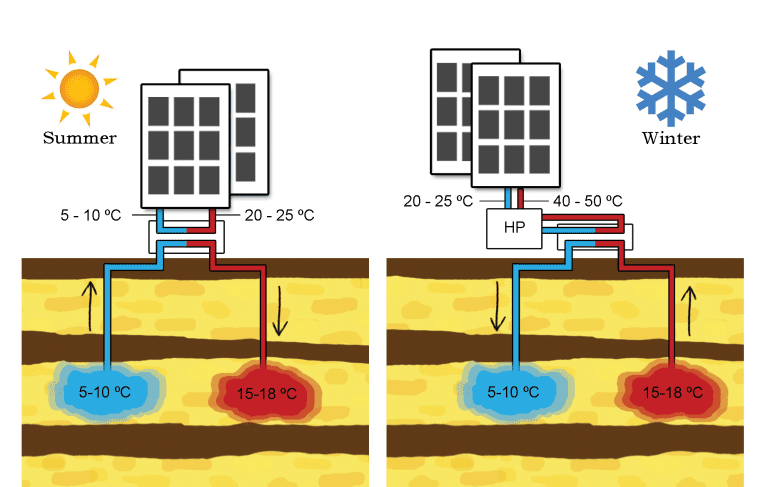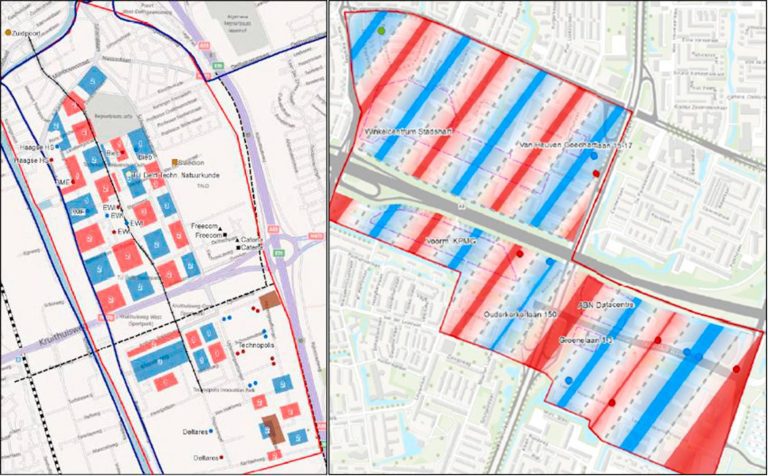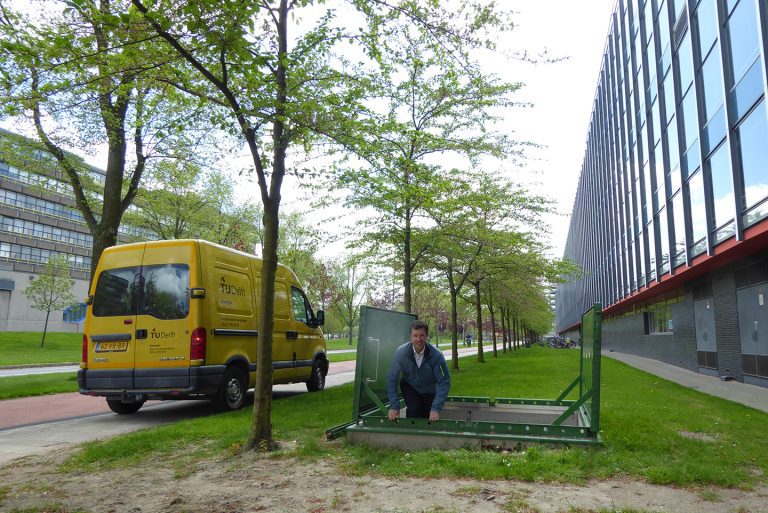The Netherlands is already a frontrunner in aquifer thermal energy storage (ATES), but it needs to be scaled up by about a hundredfold if natural gas is to be phased out, says PhD candidate Martin Bloemendal. He devised a strategy to maximise the number of ATES installations.
Martin Bloemendal in ATES well on campus. (Photo: Jos Wassink)
 Operation principle of Aquifer Thermal Energy Storage (Image: Martin Bloemendal)
Operation principle of Aquifer Thermal Energy Storage (Image: Martin Bloemendal)ATES is the most invisible form of sustainable energy. During the summer, water from the cold well is used to cool buildings. After the water has absorbed the heat from the building, it is pumped into a warm well for use during winter. The cold well typically has a temperature between 5-10 degrees Celsius, the warm well 15-18 degrees.
Seasonal thermal energy storage has been used in the Netherlands for 25 years. On the TU campus alone, thirteen doublet wells are used to heat and cool eleven buildings. These ATES systems, with aquifers at 70 metres depth, save about 5% of the total gas use of TU Delft.
The energy savings and short payback times have made ATES systems popular for utility buildings in the Netherlands. But there is room for growth. Currently, 0.2% of the 1.1 million non-residential buildings have adopted cold and heat storage systems. PhD candidate Martin Bloemendal expects a hundred-fold increase in ATES systems by 2050 as part of the effort to meet the agreed greenhouse gas emissions reduction.
Clearly, there are limits to this growth. You don’t want the stored cold and warm groundwater to overlap. The thermal radius, defined as the minimal distance from the injection well to where thermal changes can’t be measured anymore, must be respected. In real-life, geohydrologists also have to deal with horizontal and vertical flows of groundwater.
 ATES wells can be placed at random or according to planned arrangements (Image: Martin Bloemendal)
ATES wells can be placed at random or according to planned arrangements (Image: Martin Bloemendal)The key indicator of the optimal use of subsurface space is the percentage of aquifer space that is, or is expected to be, used for heat storage and recovery. After analysing existing wells and placement strategies on top of numerous simulations at a wide range of storage conditions of ATES systems, Bloemendal concludes the following.
-
For allocated fractions below 50%, no site specific planning is needed. Self-organisation together with smart design choices will facilitate ATES for the buildings in that area.
-
Beyond 50% allocation of aquifer space, the highest greenhouse gas reductions are obtained by a planned spatial arrangement of cold and warm wells in separate lanes.
 One of the thirteen ATES wells on campus (Photo: Jos Wassink)
One of the thirteen ATES wells on campus (Photo: Jos Wassink)Bloemendal, who also works part-time as a scientific researcher for geothermal energy storage at the water cycle research institute KWR, identifies a number of future challenges for ATES systems.
- Smart thermal grids: mutual communication and control strategies added to ATES systems may help make these systems adaptive. A pilot in Amsterdam has demonstrated that intelligent controllers can lead to a more optimal use of aquifer space as well as reduce greenhouse gas emissions. More similar projects are needed. Also see the corresponding faculty page.
- High-temperature ATES: industrial waste heat, heat from solar boilers or geothermal sources is available at high temperatures (60 degrees or more). Poorly insulated buildings need high-temperature input, but currently the maximum temperature for aquifer storage is 25-30 degrees. Can that temperature limit be increased?
- Climate change: more cooling in summer and less heating in winter shifts the balance between heat storage and recovery in aquifers. Eventually, the warm water will break into the cold well and make it far less efficient. Many ATES systems are already discharging surplus heat into surface water during winter to keep the ATES in balance. Can other strategies be devised?
If these issues are solved, can ATES replace natural gas? “For a large part, it can,” says Bloemendal. “Either in itself, or as an auxiliary next to a heat grid to balance the production and supply of heat. I am confident that ATES can play an important role in the energy transition.”
 ATES well on campus (Photo: Jos Wassink)
ATES well on campus (Photo: Jos Wassink)- J.M. Bloemendal, The Hidden Side of Cities, Methods for governance, planning and design for optimal use of subsurface space with ATES, PhD supervisor Professor Theo Olsthoorn, 16 May 2018.
Do you have a question or comment about this article?
j.w.wassink@tudelft.nl


Comments are closed.